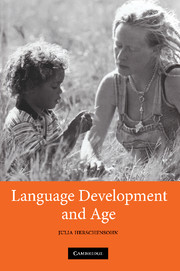Book contents
- Frontmatter
- Contents
- List of figures
- List of tables
- Preface
- Acknowledgments
- List of abbreviations
- 1 Just in time: is there a critical period for language acquisition?
- 2 Right on time: process and schedule of first language acquisition
- 3 All in good time: a window of opportunity for first language acquisition
- 4 Behind time: process and schedule of second language acquisition
- 5 Pressed for time: age constraints in second language acquisition
- 6 Biding time: further consideration of age and acquisition
- 7 It's about time: evaluation of age sensitivity in language acquisition
- Bibliography
- Index
4 - Behind time: process and schedule of second language acquisition
Published online by Cambridge University Press: 22 September 2009
- Frontmatter
- Contents
- List of figures
- List of tables
- Preface
- Acknowledgments
- List of abbreviations
- 1 Just in time: is there a critical period for language acquisition?
- 2 Right on time: process and schedule of first language acquisition
- 3 All in good time: a window of opportunity for first language acquisition
- 4 Behind time: process and schedule of second language acquisition
- 5 Pressed for time: age constraints in second language acquisition
- 6 Biding time: further consideration of age and acquisition
- 7 It's about time: evaluation of age sensitivity in language acquisition
- Bibliography
- Index
Summary
Introduction
Alice Kaplan (1993, 47) describes the initial phase of her time in a French Swiss boarding school when she hears her roommates speaking German, a language she doesn't know. “Then I started discriminating the vowels from the consonants. The same sounds repeated themselves again and again – those were words – and then I could hear the difference between the verbs and the nouns. I heard the articles that went with the nouns, and then I heard where the nouns and the verbs went in sentences.” Kaplan, in this early encounter with German, starts where all language learners must, with the segmentation of the speech stream into phonemes, morphemes, syntactic categories and combinatorial syntax. Her autobiographical account takes her from high school in Switzerland to a position as professor of French literature at Yale University, an odyssey that covers the progressive refinement of her French language skills.
While Kaplan's mastery of French gives her competence comparable to a native speaker, the path to that competence seems to differ from the pattern of L1A. The apparent lack of generalized process and schedule for second language acquisition is at first glance quite different from the tightly choreographed timeline of first language acquisition, to the point that some linguists claim that the two enterprises are not at all similar (Bley-Vroman 1990; Clahsen and Muysken 1996; Meisel 1997a).
- Type
- Chapter
- Information
- Language Development and Age , pp. 100 - 133Publisher: Cambridge University PressPrint publication year: 2007



